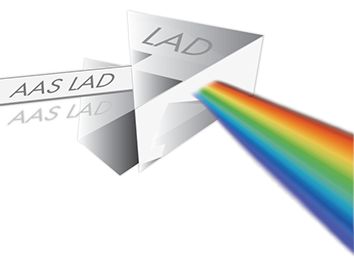Auroral Electron Acceleration
Here we describe the results in our recent paper in Nature Communications 12:3103 (2021),
Laboratory measurements of the physics of auroral electron acceleration by Alfven waves
The paper has also been featured as an Editor's Highlight for Nature Communications in the research area of “Astronomy and Planetary Science.”
Space Physics in the Laboratory
In the effort to demonstrate the physics of auroral electron acceleration by Alfven waves in the laboratory, an obvious question arises: how can one reconcile the enormous difference in the length and time scales found in Earth's magnetosphere with what can be achieved in a terrestrial laboratory? For example, the electron acceleration in our experiment occurs over distances of tens of meters and times of a few microseconds, whereas the same acceleration occurs over tens of thousands of kilometers and tens of seconds in the magnetosphere. The answer is that the physical equations governing the evolution of the system remain invariant through a careful scaling of the length scales, time scales, and other dimensional parameters of the system. This powerful approach, known as similarity analysis (Barenblatt, 1996), was exploited to create conditions in the laboratory to correspond appropriately to the conditions found in space. Through dimensional analysis, the physical behavior of a given system can be found to depend on a minimal number of dimensionless parameters, as shown by Buckingham in 1914, commonly known as the Buckingham "Pi Theorem" (Buckingham, 1914).
One of the most famous applications of similarity analysis occurred in 1950 when British physicist G. I. Taylor used declassified photos of the first atomic explosion in New Mexico, which had been published in Life magazine, to estimate accurately the yield of that atomic weapon test (Taylor, 1950a,b), information that remained highly classified at that time.

The use of similarity analysis to create experimental conditions that probe the physics of nuclear weapons is central to the US government's efforts to maintain and ensure the safety of our nuclear stockpile. In fact, the high-energy density physics community has taken full advantage of similarity analysis to design laboratory experiments using some of the most powerful lasers ever built to explore the physics of supernova explosions and the nonlinear evolution of their remnants (Ryutov et al., 1999; Drake, 2000; Remington et al.,2006) Such scientific efforts to exploit similarity analysis to investigate the physics of extreme astrophysical environments has been dubbed "laboratory astrophysics." Although the high-energy density environments relevant to supernova explosions require the use of international laser facilities, scaled laboratory experiments are also ideal to explore the physics at the lower energy densities that are typical of many heliospheric and less extreme astrophysical environments (Howes, 2018). The value of such an approach to investigate experimentally the physics of space and astrophysical plasmas led to the creation in 2012 of the Laboratory Astrophysics Division (LAD) of the American Astronomical Society (AAS).
The particular capabilities of the Large Plasma Device (LAPD) at UCLA's Basic Plasma Science Facility (BAPSF), a Department of Energy and National Science Foundation collaborative research facility, enable scaled laboratory experiments to explore the physics of space plasmas, here the acceleration of auroral electrons by Alfven waves under conditions relevant to the Earth's magnetosphere above the polar regions. The most important dimensionless number for the physics of Alfvenic electron acceleration is the ratio of the Alfven wave speed to the thermal speed of the electrons, having a value of about 3 at an altitude of 16,000 km (or 10,000 miles) in the Earth's auroral magnetosphere. The LAPD is a 20 meter long, 1 meter diameter cylindrical vacuum chamber wrapped in water cooled electrical coils that generate a sufficiently powerful magnetic field (0.17 Teslas, or about 3500 times stronger than the Earth's magnetic field in Los Angeles) to achieve the very high Alfven speeds. Next, the team fires a capacitor bank once per second to fill the LAPD chamber with a plasma having an electron temperature of 4 electron Volts (eV), or approximately 45,000 degrees Celsius, a relatively low temperature compared to that typical of space plasmas. With this experimental set up, the key ratio of the Alfven wave speed to the electron thermal speed achieved in the experiment was 2.9, corresponding to the conditions at an altitude above the Earth's surface of about 16,000 km, or 10,000 miles. By launching an Alfven wave into the LAPD plasma under these conditions, the team was able to measure the acceleration of a small population of electrons in the plasma that correspond to those electrons accelerated toward the Earth that ultimately lead to the glowing of the aurora.
References
- Barenblatt, G. I. (1996). Scaling, Self-similarity, and Intermediate Asymptotics. Cambridge University Press.
- Buckingham, E. (1914). On Physically Similar Systems; Illustrations of the Use of Dimensional Equations. Phys. Rev., 4:345.
- Drake, R. P. (2000). The design of laboratory experiments to produce collisionless shocks of cosmic relevance. Phys. Plasmas, 7:4690.
- Howes, G. G. (2018). Laboratory space physics: Investigating the physics of space plasmas in the laboratory. Physics of Plasmas, 25:055501.
- Remington, B. A., Drake, R. P., and Ryutov, D. D. (2006). Experimental astrophysics with high power lasers and Z pinches. Rev. Mod. Phys., 78:755.
- Ryutov, D., Drake, R. P., Kane, J., Liang, E., Remington, B. A., and Wood-Vasey, W. M. (1999). Similarity Criteria for the Laboratory Simulation of Supernova Hydrodynamics. Astrophys. J., 518:821.
- Taylor, G. (1950a). The Formation of a Blast Wave by a Very Intense Explosion. I. Theoretical Discussion. Proc. Roy. Soc., 201:159.
- Taylor, G. (1950b). The Formation of a Blast Wave by a Very Intense Explosion. II. The Atomic Explosion of 1945. Proc. Roy. Soc., 201:175.